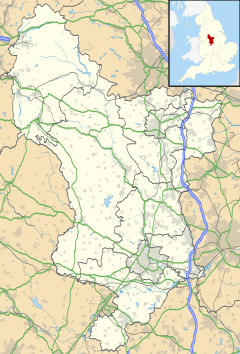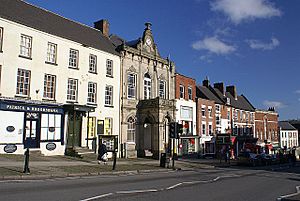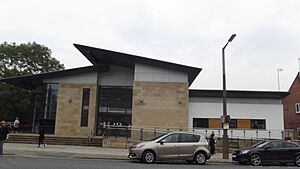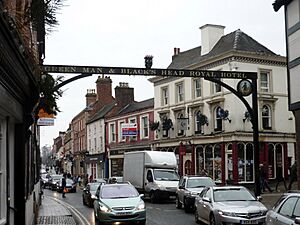Ashbourne, Derbyshire facts for kids
Quick facts for kids Ashbourne |
|
|---|---|
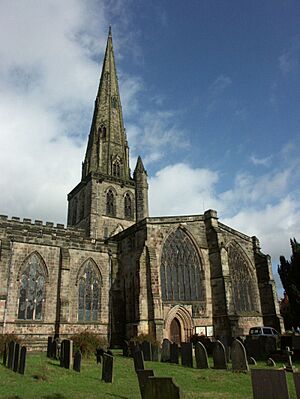 St Oswald's Church, the parish church of Ashbourne and a grade I listed building. |
|
| Population | 8,377 (Parish, 2011) |
| OS grid reference | SK1846 |
| Civil parish |
|
| District |
|
| Shire county | |
| Region | |
| Country | England |
| Sovereign state | United Kingdom |
| Post town | ASHBOURNE |
| Postcode district | DE6 |
| Dialling code | 01335 |
| Police | Derbyshire |
| Fire | Derbyshire |
| Ambulance | East Midlands |
| EU Parliament | East Midlands |
| UK Parliament |
|
Ashbourne is a lively market town located in Derbyshire, England. It's found in the Derbyshire Dales area. In 2011, about 8,377 people lived there, and by 2019, this number had grown to around 9,163.
The town is famous for its many old buildings and unique shops. Every year, it hosts a special and historic Shrovetide football match. Ashbourne is also known as the "gateway" to Dovedale. This beautiful valley is on the edge of the Peak District National Park.
Ashbourne is about 14 miles (23 km) west of Derby and 21 miles (34 km) south-east of Buxton. Other nearby towns include Matlock, Uttoxeter, and Bakewell.
Contents
History of Ashbourne
The name Ashbourne comes from an old English phrase. It means "stream with ash trees."
Ashbourne was given permission to hold a market in 1257. In the Middle Ages, it was a common resting place for pilgrims. These travelers were walking to a holy shrine in Dunstable.
In 1745, the forces of Charles Edward Stuart passed through Ashbourne. This happened during the Jacobite rising of 1745.
How Ashbourne is Governed
Ashbourne has a Town Council that helps run the town. It is made up of 13 councillors. These councillors represent four different areas: Belle Vue, Hilltop, Parkside, and St Oswald's. The council meets at the Ashbourne Town Hall.
Geography of Ashbourne
Ashbourne is located at 53°01′N 01°44′W / 53.017°N 1.733°W. Small villages like Ashbourne Green and Sturston are very close by.
The Henmore Brook flows through the middle of the town. This brook is a small river that flows into the River Dove. Ashbourne is about 400 feet (122 m) above sea level.
Economy and Jobs
For many years, a company called Nestlé had a factory in Ashbourne. From 1910, this factory made cream and condensed milk. It even had its own railway tracks. This allowed special milk trains to take products to places like London.
The factory closed in 2003. The land was later used to build homes and small businesses. Water from a well at the site was sold as "Ashbourne Water" for a while. However, sales dropped, and the water brand was stopped in 2006.
Tourism is now very important for Ashbourne. Many visitors come because the town is close to Dovedale and the Peak District. A visitor information centre is available in the town hall to help tourists.
Culture and Community
Ashbourne has a traditional outdoor market. It takes place every Thursday and Saturday in the cobbled market place. This market adds to the town's many unique shops.
In 2005, Ashbourne became a Fairtrade Town. This means many local businesses, cafes, and shops support fair trade practices.
Ashbourne Shire Horse Show
The Ashbourne Shire Horse Society started in 1881. Its goal was to improve the quality of Shire horses in the area. They held their first show that same year, and it was a big success.
The show has been held almost every year since then. It only stopped for a few years during wars or due to foot-and-mouth disease. Over time, the show grew to include other animals like cattle and sheep.
"The show aims to encourage excellence in farming and animal care. It also provides information, education, and entertainment for the local community and visitors every August."
Local Media
For local news and TV, people in Ashbourne watch BBC East Midlands and ITV Central.
Ashbourne has several local radio stations:
- BBC Radio Derby on 104.5 FM
- Smooth East Midlands on 106.6 FM
- Capital Midlands on 102.8 FM
- Greatest Hits Radio Midlands on 96.7 FM
The Ashbourne News Telegraph is the town’s weekly local newspaper.
Famous Landmarks
Ashbourne has several public houses and social clubs. One of the most famous is the Green Man & Black's Head Royal Hotel. It closed for a while but reopened in 2018.
A very old and unique sign hangs across St John's Street. It's called the "gallows sign" and has long been a meeting spot in town. In 2020, a part of the sign was removed due to public discussion. It is now being kept safely in the local area.
Transport in Ashbourne
Railway History
Ashbourne once had its own railway station. It was part of a line that went to Buxton. This line opened for passengers in 1899. However, regular passenger trains stopped running in 1954.
Today, the closest train stations are Uttoxeter, about 12 miles away, and Derby, about 13 miles away.
The old railway line from Ashbourne to Parsley Hay has been turned into a popular path. It's called the Tissington Trail. People can walk and cycle along it.
Bus Services
Bus services in Ashbourne are provided by High Peak Buses and TrentBarton. There is a bus every hour between Derby and Uttoxeter that stops in Ashbourne. Other bus routes connect the town to places like Matlock, Leek, and Buxton.
Fun Activities
The Tissington Trail starts in Ashbourne. This path follows the old railway line. You can access it through a tunnel near the leisure centre car park. The trail goes through the village of Tissington and connects to the High Peak Trail.
The Limestone Way is another walking path that passes near Ashbourne. It goes through villages like Tissington and Thorpe. There are several ways for walkers to get from Ashbourne to the Limestone Way.
Education
The main secondary school in Ashbourne is Queen Elizabeth's Grammar School. It was founded a long time ago, in 1585. The school moved to its current location in 1909.
Religious Buildings
St Oswald's Church has a tall spire that is 215 ft (66 m) high. The church was built around 1220 in an Early English style. You can still see parts of older Norman designs and a piece of a Saxon cross inside.
The church of St John was built in 1871. It has a neo-Norman style. Local churches in Ashbourne work together as "Ashbourne Churches Together" (ACT). They have a special connection with a church group in Patna, India. They even help support children's education in a school in Bihar, which is one of India's poorer states.
Sports and Games
Ashbourne is famous for its annual two-day Royal Shrovetide Football Match. In this game, one half of the town plays against the other. The whole town becomes the "pitch," and the goals are three miles apart! Thousands of players compete with a special cork-filled ball.
The game is played by two teams, the Up'ards and the Down'ards. It lasts for two eight-hour periods. The game is a moving crowd of people, called the "Hug." It moves through the town's roads, across fields, and even along the Henmore Brook. This game has been played for many centuries.
Before the 1966 FIFA World Cup, the West German football team stayed near Ashbourne. They trained on one of the town's football pitches.
A local person, Dave Mellor, became the 1978 BriSCA Formula 1 Stock Cars World Champion.
Notable People from Ashbourne
- Sir Aston Cockayne (1608–1684)
- Catherine Pegge (born around 1635) – lived in Yeldersley.
- Henry Cantrell (1684–1773) – a clergyman, born here.
- Hill Boothby (1708–1756) – a friend of Samuel Johnson, born here.
- Thomas Brown (1708–1780) – a Garter King of Arms, born here.
- Sir Brooke Boothby, 6th Baronet (1744–1824) – a poet, born here.
- William Corden the Elder (1795–1867) – a portrait painter.
- Francis Wright (1806–1873) – an industrialist and helper of others. A memorial to him is in Ashbourne Market Place.
- Catherine Booth (1829–1890) – known as the "mother" of the Salvation Army, born here.
- Francis Charles Robert Jourdain (1865–1940) – an ornithologist (bird expert), born here.
- David Redfern (1935–2014) – a photographer.
- Roy Wood (born 1946) – a musician, lives here.
- Andrew Lewer (born 1971) – a politician, lived here and went to Queen Elizabeth's Grammar School.
- James Rutledge (born 1978) – a musician and producer.
- Dave Tyack (1978 – c. 2002) – a guitarist, drummer, and singer.
- Paris Paloma (born 1999) – an English singer-songwriter and guitarist.
Images for kids
See also
 In Spanish: Ashbourne (Derbyshire) para niños
In Spanish: Ashbourne (Derbyshire) para niños


